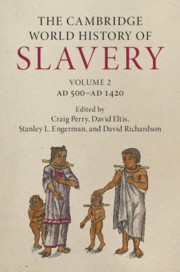Book contents
- The Cambridge World History of Slavery
- The Cambridge World History of Slavery
- The Cambridge World History of Slavery
- Copyright page
- Contents
- Figures
- Contributors
- Chapter 1 Slavery in the Medieval Millennium
- Part I Captivity and the Slave Trade
- Part II Race, Sex, and Everyday Life
- Part III East and South Asia
- Part IV The Islamic World
- Part V Africa, the Americas, and Europe
- Index
Chapter 1 - Slavery in the Medieval Millennium
Published online by Cambridge University Press: 09 September 2021
- The Cambridge World History of Slavery
- The Cambridge World History of Slavery
- The Cambridge World History of Slavery
- Copyright page
- Contents
- Figures
- Contributors
- Chapter 1 Slavery in the Medieval Millennium
- Part I Captivity and the Slave Trade
- Part II Race, Sex, and Everyday Life
- Part III East and South Asia
- Part IV The Islamic World
- Part V Africa, the Americas, and Europe
- Index
Summary
General readers still lack awareness of the prevalence of slavery between the classical period and the post-1420 wider Atlantic World. This phenomenon is not just temporal but geographic, in that Asia, the Indian Ocean World, Amerindian societies and Oceania still receive far less scholarly attention than their populations warrant. This situation exists despite the rapid growth of interest in the general subject of slavery in recent decades. The Islamic conquests and the Mongol expansions generated large numbers of captives, but in fact no society in the Medieval millennium was without enslaved people. While no consensus on the definition of slavery is possible – in this era it assumed a wide spectrum of dependencies - the existence of slave markets across the known world indicates that buyers and sellers shared enough of a common understanding of the practice to sustain a vibrant slave trade. Despite this traffic and major military disruptions, many enslaved people derived their status via birth even though the sources suggest that probably most slaves were female. They also exercised some agency. Prejudice against black people is apparent but the ebb and flow of empires ensured that any group could be a slave, just as any could be a slave owner.
- Type
- Chapter
- Information
- The Cambridge World History of Slavery , pp. 1 - 24Publisher: Cambridge University PressPrint publication year: 2021
- 2
- Cited by

